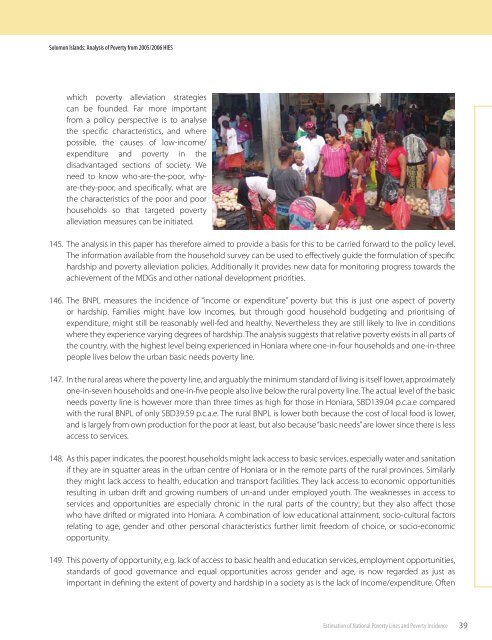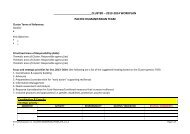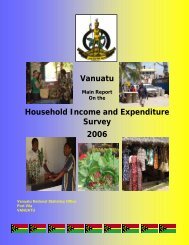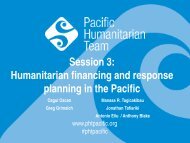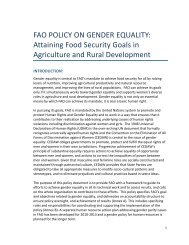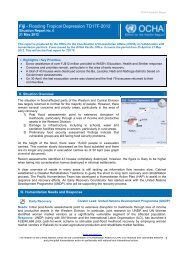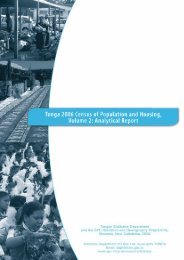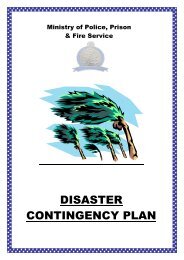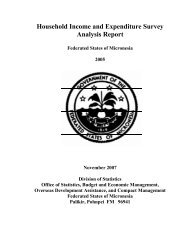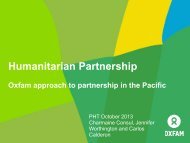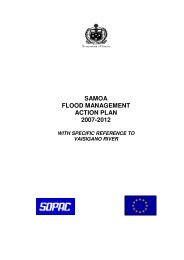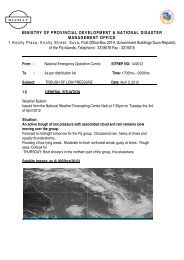Solomon Islands - Asia & the Pacific
Solomon Islands - Asia & the Pacific
Solomon Islands - Asia & the Pacific
Create successful ePaper yourself
Turn your PDF publications into a flip-book with our unique Google optimized e-Paper software.
<strong>Solomon</strong> <strong>Islands</strong>: Analysis of Poverty from 2005/2006 HIESwhich poverty alleviation strategiescan be founded. Far more importantfrom a policy perspective is to analyse<strong>the</strong> specific characteristics, and wherepossible, <strong>the</strong> causes of low-income/expenditure and poverty in <strong>the</strong>disadvantaged sections of society. Weneed to know who-are-<strong>the</strong>-poor, whyare-<strong>the</strong>y-poor,and specifically, what are<strong>the</strong> characteristics of <strong>the</strong> poor and poorhouseholds so that targeted povertyalleviation measures can be initiated.145. The analysis in this paper has <strong>the</strong>refore aimed to provide a basis for this to be carried forward to <strong>the</strong> policy level.The information available from <strong>the</strong> household survey can be used to effectively guide <strong>the</strong> formulation of specifichardship and poverty alleviation policies. Additionally it provides new data for monitoring progress towards <strong>the</strong>achievement of <strong>the</strong> MDGs and o<strong>the</strong>r national development priorities.146. The BNPL measures <strong>the</strong> incidence of “income or expenditure” poverty but this is just one aspect of povertyor hardship. Families might have low incomes, but through good household budgeting and prioritising ofexpenditure, might still be reasonably well-fed and healthy. Never<strong>the</strong>less <strong>the</strong>y are still likely to live in conditionswhere <strong>the</strong>y experience varying degrees of hardship. The analysis suggests that relative poverty exists in all parts of<strong>the</strong> country, with <strong>the</strong> highest level being experienced in Honiara where one-in-four households and one-in-threepeople lives below <strong>the</strong> urban basic needs poverty line.147. In <strong>the</strong> rural areas where <strong>the</strong> poverty line, and arguably <strong>the</strong> minimum standard of living is itself lower, approximatelyone-in-seven households and one-in-five people also live below <strong>the</strong> rural poverty line. The actual level of <strong>the</strong> basicneeds poverty line is however more than three times as high for those in Honiara, SBD139.04 p.c.a.e comparedwith <strong>the</strong> rural BNPL of only SBD39.59 p.c.a.e. The rural BNPL is lower both because <strong>the</strong> cost of local food is lower,and is largely from own production for <strong>the</strong> poor at least, but also because “basic needs” are lower since <strong>the</strong>re is lessaccess to services.148. As this paper indicates, <strong>the</strong> poorest households might lack access to basic services, especially water and sanitationif <strong>the</strong>y are in squatter areas in <strong>the</strong> urban centre of Honiara or in <strong>the</strong> remote parts of <strong>the</strong> rural provinces. Similarly<strong>the</strong>y might lack access to health, education and transport facilities. They lack access to economic opportunitiesresulting in urban drift and growing numbers of un-and under employed youth. The weaknesses in access toservices and opportunities are especially chronic in <strong>the</strong> rural parts of <strong>the</strong> country; but <strong>the</strong>y also affect thosewho have drifted or migrated into Honiara. A combination of low educational attainment, socio-cultural factorsrelating to age, gender and o<strong>the</strong>r personal characteristics fur<strong>the</strong>r limit freedom of choice, or socio-economicopportunity.149. This poverty of opportunity, e.g. lack of access to basic health and education services, employment opportunities,standards of good governance and equal opportunities across gender and age, is now regarded as just asimportant in defining <strong>the</strong> extent of poverty and hardship in a society as is <strong>the</strong> lack of income/expenditure. OftenEstimation of National Poverty Lines and Poverty Incidence39


